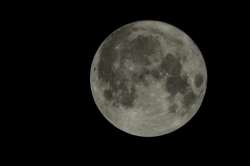Earth has a new mini-moon; and it's there since 3 years
Our new moon is probably between 1.9 and 3.5 metres across, or roughly the size of a car, making it no match for Earth’s primary moon. It circles our planet about once every 47 days on a wide, oval-shaped orbit that mostly swoops far outside the larger moon’s path.

A tiny object has been captured by the Earth and it has been pulled into the orbit. It's not the moon, but you can call it mini-moon. Researcher specialists for the Catalina Sky Survey - Kacper Wierzchos and Theodore Pruyne discovered the so-called 'mini-moon', which is an asteroid known as 2020 CD3. The asteroid is the only second asteroid known to orbit Earth. While it won't last long, it acts as a temporary mini-moon whirling around our planet.
On February 19 this year, astronomers at the Catalina Sky Survey in Arizona spotted a dim object moving quickly across the sky. Over the next few days, researchers at six more observatories around the world watched the object, designated 2020 CD3, and calculated its orbit, confirming that it has been gravitationally bound to Earth for about three years.
The survey is supported by the Near-Earth Object Observations Program, which reports into NASA's Planetary Defense Coordination Office. Specialists at Catalina help NASA discover and track near-Earth objects that could be potentially hazardous to the planet.
In this case, they found a natural satellite that was pulled into Earth's orbit three years ago. According to the researchers, the asteroid is likely between 6.2 feet and 11.4 feet in diameter.
Our new moon is probably between 1.9 and 3.5 metres across, or roughly the size of a car, making it no match for Earth’s primary moon. It circles our planet about once every 47 days on a wide, oval-shaped orbit that mostly swoops far outside the larger moon’s path.
The first known asteroid to orbit Earth, asteroid 2006 RH120, was discovered using the Catalina Sky Survey in September 2006 and is known as a TCO, or Temporarily Captured Object to astronomers.
"The story of 2006 RH120 is not without controversy, however, as it's orbit appears similar to some Apollo-era spent rockets boosters, and therefore some scientists believe it may be an artificial object," stated the survey's website.
With increasing capabilities of surveys, it's likely that more temporarily captured objects "will be discovered in the coming years, allowing for improved definition and characterization of this strange class of near-Earth objects."
Also Read | Why is NASA sending 'Dragonfly' to Titan? Here are five reasons
Also Read | NASA's InSight lander helps decode Martian weather